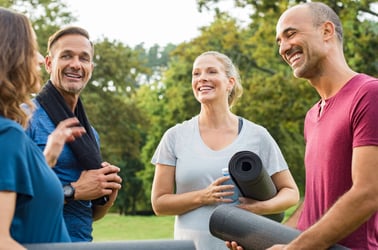 Improving and maintaining your balance is central to help prevent falls and avoid injury. There are many ways to enhance your current level of balance, whether it be getting your daily steps in by walking, taking weekly chair or standing yoga classes, or by strengthening your stability muscles to help keep your body standing strong. Balance is much more than simply standing on one leg. Consider this 3-step approach to improve your balance potential.
Improving and maintaining your balance is central to help prevent falls and avoid injury. There are many ways to enhance your current level of balance, whether it be getting your daily steps in by walking, taking weekly chair or standing yoga classes, or by strengthening your stability muscles to help keep your body standing strong. Balance is much more than simply standing on one leg. Consider this 3-step approach to improve your balance potential.
- One Foot in Front of the Other – In addition to a weekly walking goal, consider trying a balance class or dance fitness workout. Or maybe do a few daily exercises in your home, such as Tandem Arm Swings, where you place the heel of one foot against the toes of your other foot, then swing your arms next to your sides front to back. Have a sturdy chair within reach in case you need it. Do this 10 times then repeat on the opposite side at least once per day.
- Strong and Stable – Your leg, core, and arm muscles play a big role in maintaining stability. The stronger you are, the more confident you’ll be in keeping your feet on the ground. You might consider taking a strengthening class so a professional can help you learn great form. If you want a few things to try at home, consider these:
- A good exercise for stronger legs is a Sit-to-Stand. Sit at the edge of a stable chair with your arms across your chest; use the front of your legs to help you rise up; feel the chair lightly touching the back of your legs; and sit back down with control…don’t plop! Repeat for 60-seconds at your own pace.
- An upper body and core exercise to try is a modified plank against a wall. Place your hands slightly wider than your shoulders against the wall and step back about 1-2 feet. Keep your body as straight as a board while bending your arms and leaning your weight toward the wall. Hold for 10 seconds at a time and repeat 10 times.
- Stretched and Balanced – Your ability to move your body through a full range of motion helps you to maintain good posture and stability. For example, tight hips will cause your body to bend at the crease of your body where your legs meet your trunk and keep you from being able to completely stand upright. Try a seated or standing stretch or yoga class. For a simple hip stretch to do at home, stand next to a chair or counter, squeeze the muscles in your rear end as you push your hips slightly forward. An added benefit to this stretch is that it strengthens the rear of your body while you’re stretching the front. Hold for 10 seconds then repeat 3-4 times daily.
Balance improvements can be made by simple changes done consistently over time. It is not a quick process but if you set up daily and weekly goals of making exercise a habit, you will see positive changes over time. Moving, strengthening, and stretching is vital for maintaining your mobility.


 Flexibility is often overlooked in fitness training, but Jabbar Harris another one of our dedicated fitness specialists knew just how powerful it could be. He led the flexibility portion of the superpowers program and guided residents through regular stretching routines designed to safely increase their range of motion, and comfort. One of his participants, Olivia Q., experienced dramatic improvements going from four inches short of her toes to reaching two inches past them - that's a 150% increase in flexibility! She shared with Jabbar that performing the stretches most days of the week not only improved her flexibility but also alleviated soreness in her lower back! Olivia's lower back discomfort went from a self reported “seven” to a “three”. Since completing the Superpowers program, Olivia has continued to incorporate stretching into her daily routine to maintain her new superpower.
Flexibility is often overlooked in fitness training, but Jabbar Harris another one of our dedicated fitness specialists knew just how powerful it could be. He led the flexibility portion of the superpowers program and guided residents through regular stretching routines designed to safely increase their range of motion, and comfort. One of his participants, Olivia Q., experienced dramatic improvements going from four inches short of her toes to reaching two inches past them - that's a 150% increase in flexibility! She shared with Jabbar that performing the stretches most days of the week not only improved her flexibility but also alleviated soreness in her lower back! Olivia's lower back discomfort went from a self reported “seven” to a “three”. Since completing the Superpowers program, Olivia has continued to incorporate stretching into her daily routine to maintain her new superpower. 
 Did you know by the time we reach age 30 we have reached what is called our “peak bone mass”? According to the American Academy of Orthopedic Surgeons, most of us will reach this peak between the ages of 25 and 30. As we age, it is imperative we are aware of the signs of Osteoporosis and how we can combat these symptoms and risk factors.
Did you know by the time we reach age 30 we have reached what is called our “peak bone mass”? According to the American Academy of Orthopedic Surgeons, most of us will reach this peak between the ages of 25 and 30. As we age, it is imperative we are aware of the signs of Osteoporosis and how we can combat these symptoms and risk factors. 
 Picture this: You're gliding effortlessly across a small trampoline, the rhythmic bouncing sending a gentle wave of energy through your body. This isn't just some childhood fantasy; it's rebounding, a low-impact exercise gaining popularity among senior citizens for its myriad health benefits.
Picture this: You're gliding effortlessly across a small trampoline, the rhythmic bouncing sending a gentle wave of energy through your body. This isn't just some childhood fantasy; it's rebounding, a low-impact exercise gaining popularity among senior citizens for its myriad health benefits.
 You might have heard that yoga is great for flexibility and a great opportunity to meditate. Beyond those benefits,
You might have heard that yoga is great for flexibility and a great opportunity to meditate. Beyond those benefits,  Individuals who are new to regular exercise, or those who are considering recommitting after a long hiatus, may have preconceived notions about what it takes to effectively reap the benefits of a new routine. For this reason, I want to establish a number of foundational principles and debunk some common myths surrounding fitness. Reworking your current schedule to
Individuals who are new to regular exercise, or those who are considering recommitting after a long hiatus, may have preconceived notions about what it takes to effectively reap the benefits of a new routine. For this reason, I want to establish a number of foundational principles and debunk some common myths surrounding fitness. Reworking your current schedule to 